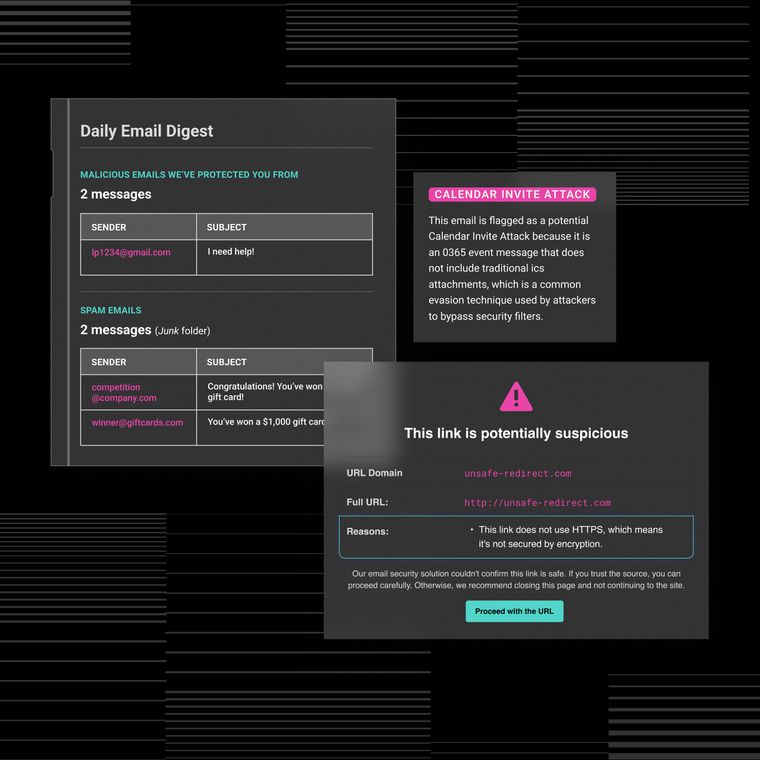Advanced Strategies to Mitigate Critical Email Risks With AI
Reduce exposure and mitigate critical email risks through advanced AI techniques.
October 15, 2025
Email attacks bypass traditional security controls, extracting sensitive data through social engineering that legacy filters cannot detect. Most breaches still originate from phishing links or spoofed addresses, with data breaches now costing organizations $4.4 million on average. This is why security teams face an urgent challenge: stopping attacks before users click.
Legacy filters relying on signatures, static rules, and SPF/DKIM/DMARC authentication fail against generative AI and zero-day tactics. These controls examine messages in isolation, missing context-driven threats like plaintext wire transfer requests. Traditional approaches overwhelm teams with false positives, manual triage, and critical blind spots after attackers compromise valid credentials.
The following seven AI-powered strategies help mitigate critical email risks:
1. Detect identity threats beyond authentication
Traditional email authentication verifies message legitimacy but fails when attackers control valid credentials. Behavioral AI turns this vulnerability into an opportunity for detection by learning how organizations actually communicate.
Valid Credentials Become Attack Weapons
Credential-based attacks slip past SPF, DKIM, and DMARC daily because these protocols verify domains, not whether attackers have compromised legitimate accounts. Once inside with stolen credentials, adversaries launch payment fraud and business email compromise campaigns, appearing entirely legitimate to traditional authentication systems.
Behavioral Patterns Expose Compromise
Geography reveals threats when finance accounts suddenly log in from unexpected countries at odd hours. Language patterns expose attacks when compromised executives request urgent wire transfers in uncharacteristic language. Platforms correlate login anomalies with linguistic changes, device fingerprints, and transaction patterns, quarantining suspicious conversations milliseconds before funds transfer.
2. Model Normal Communication Patterns With Behavioral Graphs
Mapping organizational communication creates reference points for advanced threat detection. Traditional filters examine messages in isolation, missing context-driven attacks while generating false positives. Behavioral intelligence transforms this limitation by building comprehensive communication models across three critical dimensions:
Baseline Intelligence Maps Organizational Communication: Behavioral intelligence learns how your organization actually communicates, tracking message frequency, typical recipients, and standard business hours to establish normal patterns across workforce interactions and vendor relationships.
Social Graphs Establish Reference Points: Systems stitch together login telemetry, message metadata, and content signals into living models, creating comprehensive profiles of every sender-recipient pair, including expected cadence, tone, and subject domains.
Deviations Trigger Immediate Alerts: When suppliers email from uncharacteristic domains or executives request gift cards at unusual hours, systems flag anomalies without requiring malicious links or attachment indicators present in messages.
Every email gets placed in behavioral context, transforming raw traffic into actionable intelligence. This baseline-driven detection cuts triage volume while catching subtle impersonations that traditional tools miss.
3. Stop Payload-Free Social Engineering Emails
Payload-free attacks bypass traditional scanners, containing no malicious links or attachments, only persuasive text manipulating psychology. Generative AI crafts personalized lures exploiting this blind spot daily.
Static Engines Fail Without Malware Signatures
Simple requests like gift card purchases pass authentication checks, landing directly in inboxes. Without payloads, systems default to "benign": a critical flaw that attackers exploit. Threat actors mimic executive styles, alter reply-to addresses, and inject urgency markers triggering human reflexes rather than technical alarms.
Behavioral Intelligence Analyzes Linguistic Patterns
Large language models examine every message after authentication succeeds, scoring tone shifts, formality changes, and urgency phrases against sender baselines. Systems correlate linguistic anomalies with identity telemetry.
When the usual CFO prose suddenly becomes urgent wire requests, platforms quarantine emails instantly. This language-aware approach detects social engineering attempts that lack traditional indicators, preventing employees from responding to fraudulent requests.
4. Close Vendor Email Compromise Gaps
Attackers exploit trusted supplier relationships, making vendor email compromise the most expensive BEC variant. Modern platforms learn each supplier's normal behavior to identify sophisticated impersonations. Effective vendor protection requires comprehensive monitoring across the following key areas:
Supplier Baselines Prevent Sophisticated Fraud: Modern platforms learn each vendor's normal behavior, including sending domains, typical invoice amounts, and customary approval chains to identify deviations humans rarely notice during routine operations.
Anomalies Trigger Immediate Protective Actions: Invoices jumping exponentially, altered wire destinations, or replies from look-alike domains generate alerts while systems correlate signals across OAuth grants, suspicious logins, and payment-request chatter.
Cross-Channel Visibility Confirms Attack Intent: When risk exceeds thresholds, platforms quarantine emails, alert finance teams, and require step-up authentication for vendor accounts before funds transfer to criminal-controlled destinations worldwide.
This multi-layered approach prevents supplier impersonation attacks that cost organizations millions through fraudulent invoices and payment redirections.
5. Reduce Alert Noise Through Intelligent Triage
Intelligent triage converts low-confidence detections into actionable incidents. Traditional filters generate excessive false positives through static rules while sophisticated attacks bypass rigid patterns, overwhelming teams with noise that buries real threats.
Dynamic Risk Scoring Weighs Behavioral Signals
AI-driven detection solves this through contextual analysis. Platforms ingest identity telemetry, including unusual login locations, failed MFA attempts, and privilege escalations, correlating events with email anomalies. Each incident receives contextual scores based on relationship patterns rather than isolated signatures.
Native Integrations Streamline Security Operations
REST APIs feed enriched incident data directly into Splunk, Microsoft Sentinel, and Cortex XSOAR. Automated workflows quarantine suspicious messages, trigger authentication, or create tickets before users interact with threats. Models continuously learn from attack patterns, improving accuracy.
This approach reduces both false positives and negatives, allowing security teams to focus on genuine threats rather than alert fatigue.
6. Protect The Saas Ecosystem Connected To Email
Compromised email accounts create pathways into the entire SaaS infrastructure. Email serves as an authentication hub for modern workplaces, making it critical for ecosystem-wide security. Comprehensive protection requires monitoring three interconnected attack vectors:
OAuth Tokens Create Ecosystem Vulnerabilities: Compromised email accounts store OAuth grants that function as master keys, granting access to chat archives, meeting schedules, and file repositories without returning to the original inboxes.
Continuous Auditing Prevents Lateral Movement: Modern platforms monitor token scopes, track refresh patterns, and analyze third-party app authorizations, automatically revoking access before attackers pivot across connected SaaS applications and collaboration platforms.
Correlation Surfaces Unified Security Incidents: Advanced solutions analyze events across email, Slack, Teams, and Zoom simultaneously, examining sender reputation and conversation context instead of generating fragmented alerts across disconnected security tools.
7. Enable Automated Context-Aware Response
Automated response converts detected threats into immediate protective action, shrinking response times from hours to seconds. Behavioral AI triggers precise remediation based on risk thresholds.
Behavioral Thresholds Trigger Immediate Remediation
Behavioral models score every user, vendor, and message in real time. When thresholds cross, systems disable accounts, revoke OAuth tokens, and force password resets during the attacker's dwell time, preventing lateral movement.
Post-Delivery Protection Neutralizes Active Threats
Scanning retracts offending emails, neutralizes embedded links, and notifies recipients without awaiting analyst approval. Platforms attach confidence scores to every detection, mapping specific actions to defined risk bands. High-fidelity incidents execute remediation through pre-built SOAR playbooks.
Build AI-Driven Email Resilience With Abnormal
Modern email threats exploit trust, identity, and subtle manipulation that traditional defenses cannot detect. These seven strategies transform email from a primary attack vector into a comprehensive defensive system.
Behavioral AI detects identity threats beyond authentication, while communication pattern modeling intercepts attacks with precision. For instance, language-aware analysis identifies payload-free social engineering that bypasses traditional scanners. Vendor compromise protection combines supplier baselines with cross-channel visibility to prevent million-dollar fraud.
Similarly, intelligent triage reduces alert fatigue by converting low-confidence detections into actionable incidents. SaaS ecosystem monitoring prevents lateral movement through OAuth token auditing. Lastly, an automated response reduces remediation time from hours to seconds.
Ready to transform your email security with behavioral AI that helps mitigate critical email risks? Get a demo to see how Abnormal can help!
Related Posts
Get the Latest Email Security Insights
Subscribe to our newsletter to receive updates on the latest attacks and new trends in the email threat landscape.


